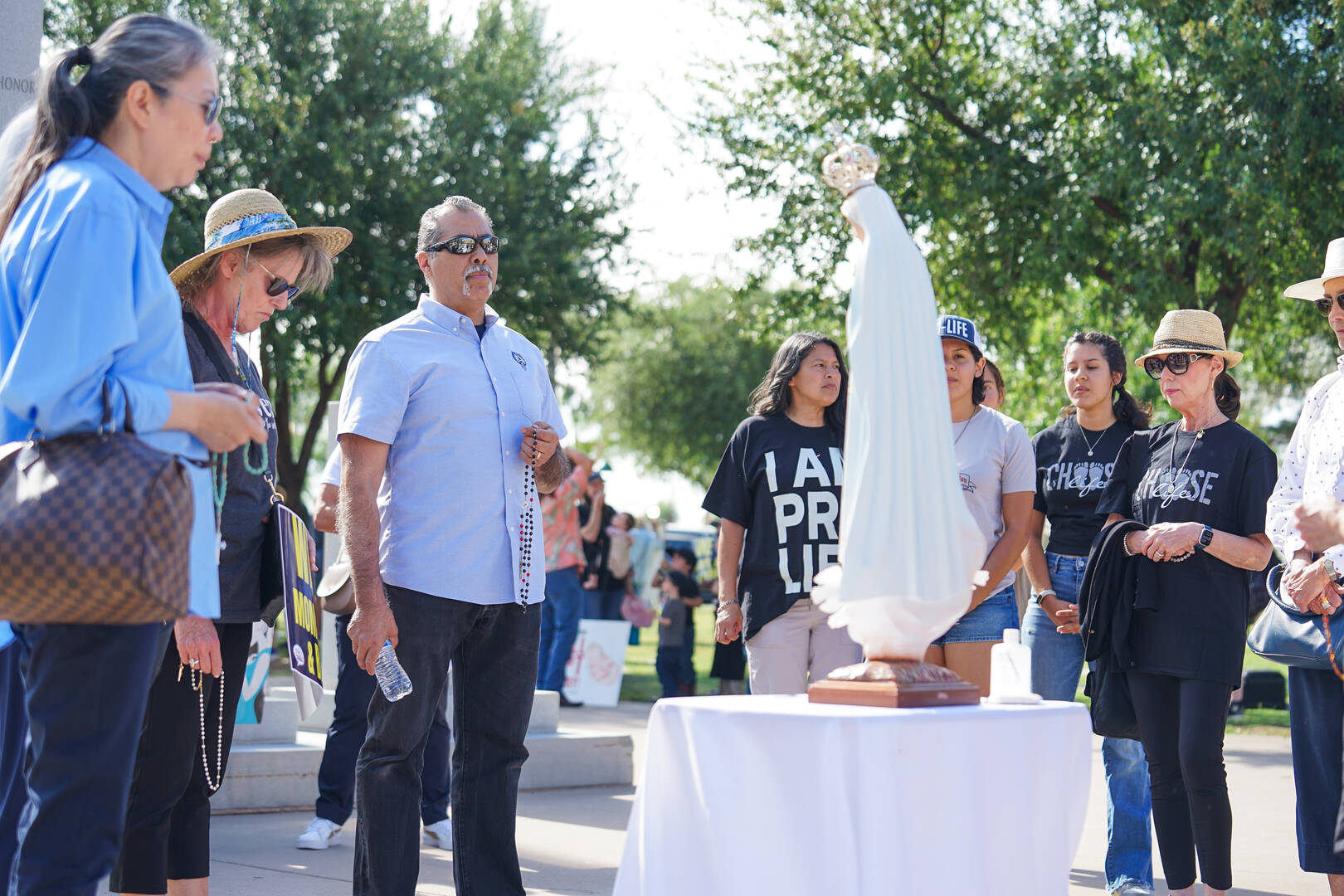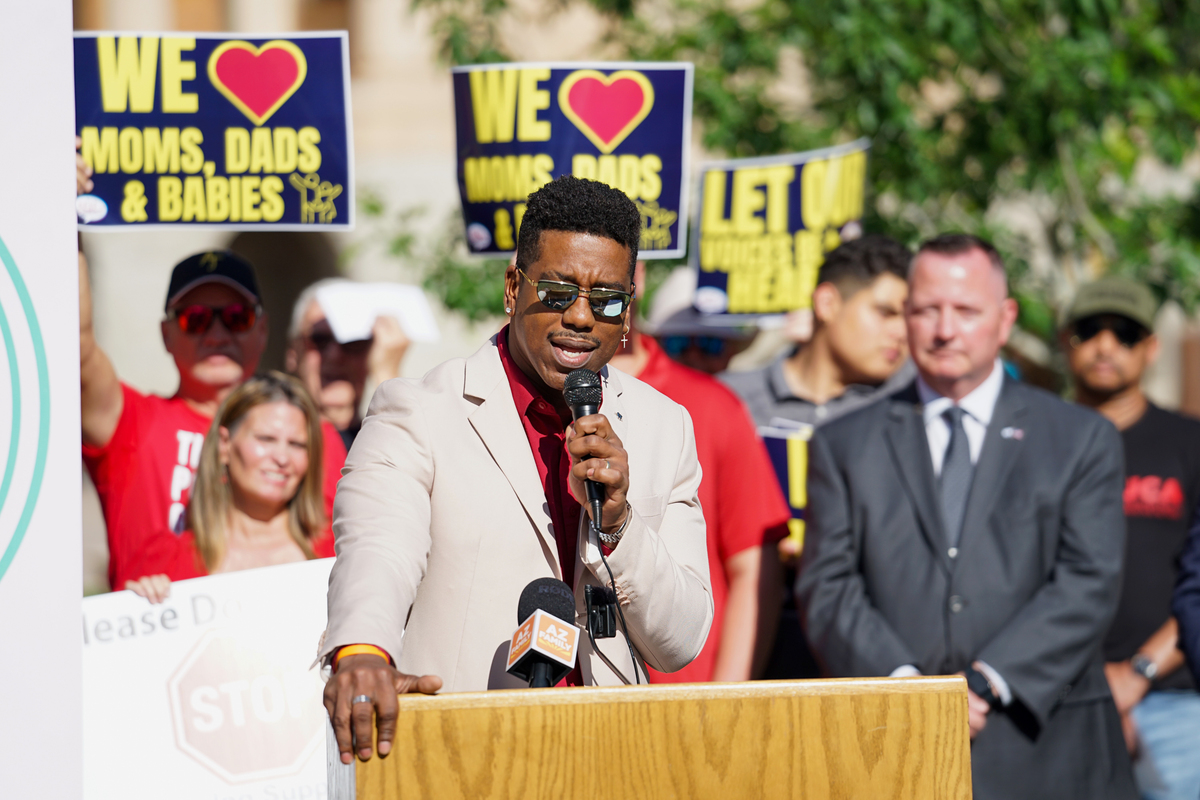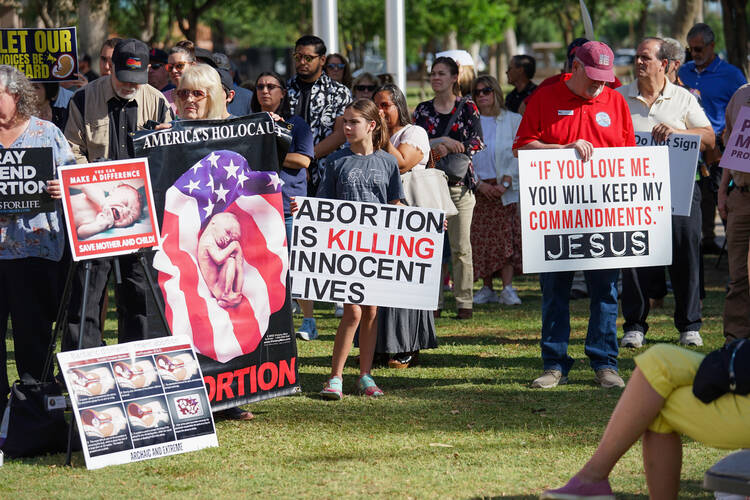Dozens of pro-life advocates gathered at the Arizona Capitol on the morning of April 24, hoisting signs that reflected the movement’s increasingly diverse methods. One gentleman held a sign that read, “If you love me, you will keep my commandments.” Other signs ranged from “Pray to end abortion” and “We love moms, dads & babies” to “Abortion is killing innocent lives” and “America’s Holocaust: Abortion.” Still others included graphic photographs of aborted children.
Abortion became a state issue two years ago after the Supreme Court’s landmark decision in Dobbs v. Jackson Women’s Health Organization, which overturned Roe v. Wade. What is playing out in Arizona this year has already played out in other states.
At the capitol this April, pro-life advocates urged state legislators to uphold the state’s 1864 abortion law, which the state government recodified in 1977. The law would have banned abortion except in cases when the mother’s life was at risk. Despite the protest, the state House of Representatives repealed the law later that day. The state Senate followed suit on May 1.
Republicans, it bears noting, currently have majorities in both Arizona’s House and Senate.
Given that efforts to restrict abortion have met with mixed results, what should be the focus of the pro-life movement going forward? Should measures like Arizona’s 1864 abortion law be pursued, or is it time to find a middle ground? America asked national pro-life experts as well as advocates working at the grassroots.
Enforceable pro-life laws
Jesse Romero, a popular Catholic evangelist and retreat leader, led a group praying the rosary at the Arizona Capitol. He said the church’s opposition to abortion has been clear since 70 A.D., as it was articulated in the Didache. Mr. Romero did not mince words.
“The bishops in every state should thunderously proclaim what the Catholic Church teaches, and start excommunicating Catholic politicians if they transgress Catholic teaching,” he told America. “As Catholics, we don’t believe in exceptions. We believe that life is sacred, no matter where it comes from, including rape or incest. It doesn’t matter.”
Others at the rally shared similar sentiments. But national pro-life leaders explained that it is difficult to pass or maintain pro-life legislation without some exceptions. The National Right to Life Committee, for example, has supported legislation that would allow abortion in case of rape or incest or when the life of the mother is in danger.
“It’s not that we want to allow or make exceptions, but we’ve always had this goal of wanting to protect as many babies as possible, as soon as possible,” Carol Tobias, the president of National Right to Life, told America. Efforts that insist on “perfect” legislation may fail, resulting in no abortion restrictions. “That doesn’t work for us,” Ms. Tobias said.
“If we can’t change the law, we’ll try to save the babies in other ways,” she said. “We’re working to change the law and the culture, so regardless of the law, babies can still be saved.”

Ms. Tobias did question why some self-described pro-life Arizona legislators voted to repeal the 1864 law, allowing a previously passed 15-week ban to take effect. “That would allow 95 percent of abortions to continue,” she said, noting that saving only 5 percent of babies is not enough. The overwhelming majority of abortions take place before 15 weeks.
On the other hand, Clarke Forsythe, the senior counsel for Americans United for Life, noted that Arizona’s 15-week ban was a “stronger position to defend against a ballot initiative.” And Arizona voters indeed may have an initiative on the ballot this November that would liberalize access to abortion well beyond the current limits.
In the last two years, seven states have had ballot initiatives that liberalized access to abortion, and all seven passed. Conversely, 14 state governments have restricted access to abortion.
“You can criticize legislators all you want, but it’s obvious that there was insufficient public or political support,” Mr. Forsythe said of Arizona repealing the 1864 law. “There has to be strong public support for abortion laws or they’re not going to be effectively enforced.”
Mr. Forsythe, author of Pushing Roe v. Wade Over the Brink, said the focus should be more on achieving what is possible. Given public sentiments, he said, abortion restrictions that do not make exceptions for the cases of rape and incest are unenforceable.
“We need to be prudent,” Mr. Forsythe said. “We have to build public support for any particular law. And this is going to be state by state.”
The pro-life movement needs to commit to understanding and shaping public sentiment, he said, noting Abraham Lincoln’s efforts in the 1850s “to build an enduring majority against slavery.” The movement must understand and appeal to Middle America.
“We need hard data, and we don’t have it in the United States,” he said, questioning reports that the rate of abortions rose over the last two years. While some Scandinavian countries, for example, have a registry of abortions, the United States relies on self-reporting.
Mr. Forsythe also argued for better public health data. Each state should annually complete and publish a women’s health index, he said, including socio-economic and health statistics like maternal mortality and morbidity.
“That’s a key necessity for us to talk about how women are doing in Mississippi versus New York, or Alabama versus California,” he said.
Rigid partisanship and refusing to work with those who disagree undermines “the cause for life,” Mr. Forsythe said. “That’s just not the real world. It’s just not how politics can be done.” Sometimes, he said, incremental gains are the only ones available.
A culture of life
The Rev. Jim Hewes, a priest in the Diocese of Rochester, N.Y., has been involved in the pro-life movement since before his ordination as a priest in 1974, one year after Roe was decided. He served for 18 years as director of Project Rachel, a healing ministry for those affected by abortion, and the last three years with a mobile ultrasound van that serves his diocese.
Over the years, Father Hewes has found different ways to talk about the pro-life cause. During one public debate, for example, he shared that he grew up with alcoholism in his family.
“My dad wasn’t bad,” he said. “He was what you’d call a functioning alcoholic. But what happens when you have the disease of alcoholism in your family is you take second place to the disease. You feel unwanted.”
While attending Al-Anon, a support group for people affected by someone else’s drinking, Father Hewes heard the same story of feeling unwanted over and over again. Almost all abortions, he said, happen because the children are also unwanted.
“That’s why I’m involved in this,” he said. “Because unwanted life is just as valuable as wanted life. The core, the inherent dignity is the same.”

Images can change the conversation, Father Hewes said, and he does not mean photos of the bodies of aborted children. He cited images of migrants who died on their way to Europe and noted how photographs helped end slavery in America.
Emmett Till, a 14-year-old boy, was beaten and shot dead in 1955 after being accused of whistling at a white woman. His mother, Mamie, chose an open-casket funeral to “let the world see what has happened because there is no way I could describe this.” What happened to Emmett Till inspired Rosa Parks not to move on the bus.
Father Hewes also noted the well-known photo by Nick Ut of a Vietnamese girl, Phan Thi Kim Phuc, fleeing a napalm bomb. It helped shape public opinion of the Vietnam War. Images of tarred lungs and people who lost their ability to speak led countless Americans to quit smoking.
“It’s a theoretical discussion without the pictures,” Father Hewes said, explaining why he used to carry a copy of the April 30, 1965, issue of Life magazine in his car. Headlined “Drama of Life Before Birth,” the issue featured a cover photograph of an 18-week-old baby in utero. Inside, Lennart Nilsson’s photographs told the story of human life from conception to 28 weeks gestation.
Images make a difference, including those currently made available by modern technology, Father Hewes said. He has seen this happen with women he has met in the mobile ultrasound van.
“The woman that was one of the first on the mobile ultrasound van came by several months ago with her baby to thank us,” he said. “The problem is abortion is seen as an abstract concept. It’s not seen as the reality.”
He cited numerous examples of individuals who, after witnessing the reality of abortion, changed their minds, including Abby Johnson, who used to work at Planned Parenthood, and Dr. Bernard Nathanson, an abortion provider who became a pro-life advocate. The advent of ultrasound technology sparked Nathanson’s conversion to the Catholic Church.
Mayra Rodriguez Villeda, who for 17 years worked for Planned Parenthood and ran three facilities, shared about her own conversion during the rally at the Arizona Capitol.
“I killed millions of babies,” she said. “I can’t give back the lives of those babies. But I can fight for the babies who do not have a voice. And I will.”
A difficult road ahead
At the Arizona Capitol, before the press conference began, a woman counter-protesting marched back and forth, brushing elbows with the pro-life advocates. She held up a sheet of paper while chanting, “Forced pregnancy is slavery!”
She walked past R.C. Maxwell, a pro-life advocate, who later shared a different perspective as a Black American.
“John Quincy Adams thought he failed as a president because he didn’t abolish slavery,” he told America. “He’s the only president who came back to Congress.”
Adams, he said, intentionally triggered a trial during which he educated his colleagues about slavery.
“Arizona has an opportunity to educate,” Mr. Maxwell said. “A baby can respond to physical stimuli as early as four weeks. Science matters. Educating about that science is the only way that we’re eventually going to get people to understand.”
The path forward, he said, should not include a middle ground.
“The only way to win is not to water down your stances,” Mr. Maxwell said. “That’s certainly not what the other side is doing. They’re not saying it’s a woman’s choice until eight months. They’re not saying that at all. We know what their mission is. And we know what our mission is—to protect the innocent.”
Pro-life advocates support 3,000 crisis pregnancy centers and mobile units in the United States. Abortion rights advocates claim the centers coerce women into carrying their pregnancies to term, and some states are trying to close them down. Meanwhile, some in the pro-life movement argue that paying for an abortion—either by an acquaintance, a family member or the government—is itself a form of coercion.
According to estimates, most abortions are now medical abortions. Women can take a regimen of mifepristone and misoprostol to end their pregnancies at home during the first 12 weeks of pregnancy. Within 48 hours of taking the abortion pill, however, it can potentially be reversed by taking progesterone. Governor Jared Polis of Colorado tried to ban the reversal practice last year over health concerns. Yet doctors, pro-life advocates are quick to note, have prescribed progesterone for more than a decade to pregnant women to prevent preterm birth.
“We are here because the pre-born cannot speak for themselves and their voices cannot be heard,” Ashley Trussell, chair of Arizona Right to Life, said during the rally. “The size and location of a person do not matter… Abortion is not healthcare. It hurts women and it hurts her child.”
Despite the different approaches within the movement, the pro-life advocates who spoke with America expressed hope for the years ahead. They noted, for example, the 32,000 estimated preborn children that have been saved post-Dobbs.
“Even though the last two years have been challenging, Dobbs lifted a huge impediment to shaping public opinion,” Mr. Forsythe said. “We have opportunities we didn’t have before. Americans’ feelings shape their understanding of the truth.”
Ms. Tobias was likewise upbeat.
“I’m in touch with pro-life people every day. Pro-life people love life. We’re just optimistic, caring, loving people,” she said. “There’s just so much being done. I’m not the only one doing this. We’ve been doing this for more than 50 years. We’re not going to stop now.”








